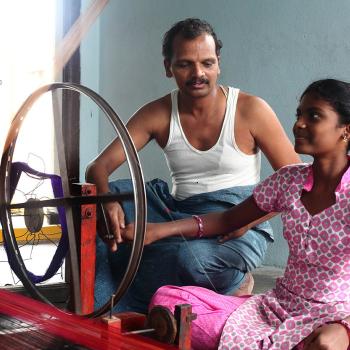
I recently attended a consultation entitled ‘Women’s Voices from the Informal Economy’ in Ahmedabad organised by the High Level Panel on Women’s Economic Empowerment . Co-hosted by the Indian trade union, the Self-employed Women’s Association (SEWA), the consultation aimed to make recommendations to improve economic outcomes for girls and women. Institutions such as ILO, WIEGO, Institute for Human Development (IHD) as well as Young Lives were invited to make presentations.
What really struck me was the field visits organised by SEWA to listen to voices of women and girls in the slums of Ahmedabad. It was truly inspiring to visit the home of one of the child-care workers and hear from the family members how she had had managed to run the home only on the salary she earned. The pride in being able to sustain the family and respect she had earned from community members and family was apparent and very moving.
The fact that 93 percent Indians still work in the informal sector and that we need 10 million new jobs to be created every year with a focus on women and girls to meet the SDG Goal of gender equality – is truly challenging. However, what was even more disconcerting was the fact that India does not have data that captures how many girls and women continue to do invisible work at home- caring for their siblings, family members as well as doing long hours of household chores or unpaid work in family farms and household enterprises.
Young Lives data provided a snapshot of work profile both paid and unpaid from all four countries (Peru, Ethiopia, Vietnam and India i.e. Andhra Pradesh and Telangana) at different ages and the decreasing enrolment of girls as they turned 19. The Young Lives analysis showcases the importance of recognising adolescence as a critical stage where key investments and effective social support systems can set girls towards the path of economic empowerment.
Achieving women’s economic empowerment is not a ‘quick fix’ and must take into consideration the life course perspective to design interventions for girls at a much younger age for instance providing quality pre-school education, ensuring they learn to read and write in early grades and not making them work for more than two hours a day in household chores at age 12 and 15, to ensure they complete secondary education.
As Young Lives collects data for its older cohort aged 22 years, we look forward to new evidence that will inform policy and practice to ensure that girls and women from the poorest and most socially disadvantaged households can both contribute and gain from the growth process and stop the cycle of intergenerational poverty.

I recently attended a consultation entitled ‘Women’s Voices from the Informal Economy’ in Ahmedabad organised by the High Level Panel on Women’s Economic Empowerment . Co-hosted by the Indian trade union, the Self-employed Women’s Association (SEWA), the consultation aimed to make recommendations to improve economic outcomes for girls and women. Institutions such as ILO, WIEGO, Institute for Human Development (IHD) as well as Young Lives were invited to make presentations.
What really struck me was the field visits organised by SEWA to listen to voices of women and girls in the slums of Ahmedabad. It was truly inspiring to visit the home of one of the child-care workers and hear from the family members how she had had managed to run the home only on the salary she earned. The pride in being able to sustain the family and respect she had earned from community members and family was apparent and very moving.
The fact that 93 percent Indians still work in the informal sector and that we need 10 million new jobs to be created every year with a focus on women and girls to meet the SDG Goal of gender equality – is truly challenging. However, what was even more disconcerting was the fact that India does not have data that captures how many girls and women continue to do invisible work at home- caring for their siblings, family members as well as doing long hours of household chores or unpaid work in family farms and household enterprises.
Young Lives data provided a snapshot of work profile both paid and unpaid from all four countries (Peru, Ethiopia, Vietnam and India i.e. Andhra Pradesh and Telangana) at different ages and the decreasing enrolment of girls as they turned 19. The Young Lives analysis showcases the importance of recognising adolescence as a critical stage where key investments and effective social support systems can set girls towards the path of economic empowerment.
Achieving women’s economic empowerment is not a ‘quick fix’ and must take into consideration the life course perspective to design interventions for girls at a much younger age for instance providing quality pre-school education, ensuring they learn to read and write in early grades and not making them work for more than two hours a day in household chores at age 12 and 15, to ensure they complete secondary education.
As Young Lives collects data for its older cohort aged 22 years, we look forward to new evidence that will inform policy and practice to ensure that girls and women from the poorest and most socially disadvantaged households can both contribute and gain from the growth process and stop the cycle of intergenerational poverty.

